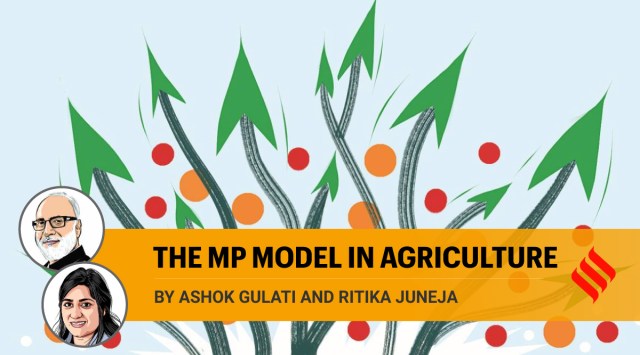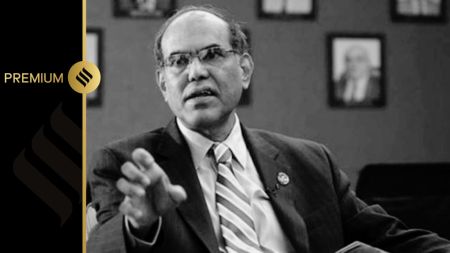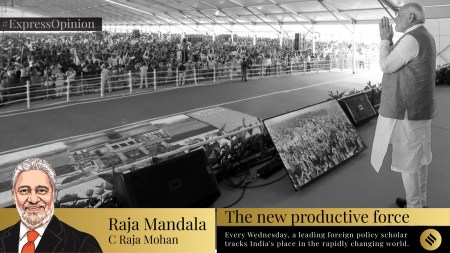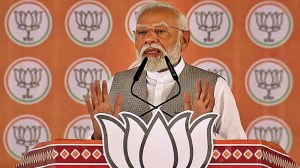- India
- International
Ashok Gulati and Ritika Juneja write: Lessons from Madhya Pradesh’s agriculture model
A well-diversified portfolio in crops is behind the high growth in the state's farm sector. This is inclusive and sustainable and offers a path for other Indian states
 To analyse how inclusive this growth has been, we look at the agri-GDP growth in BIMARU states. Madhya Pradesh has performed very well — it has clocked the highest growth rate in agriculture at 7.3 per cent. (Illustration: C R Sasikumar)
To analyse how inclusive this growth has been, we look at the agri-GDP growth in BIMARU states. Madhya Pradesh has performed very well — it has clocked the highest growth rate in agriculture at 7.3 per cent. (Illustration: C R Sasikumar) India is today a $3.5 trillion economy. If the current growth trend continues, the country is likely to be a $5.4 trillion economy by 2027 (as per IMF forecast). The Covid-19 pandemic and the Russia-Ukraine conflict have thrown the global economy into a spin and India’s ambitious target of becoming a $5 trillion economy by 2025 could be somewhat delayed, but it is definitely not out of reach. India seems to be on the right path and is doing pretty well — especially when compared to its progress in the first six decades after 1947. As per IMF, it took India almost 59 years since Independence to become a $0.95 trillion economy in 2006. But then it became a $2.3 trillion economy by 2016 — it added $1.35 trillion in 10 years. And in 2022, it became a $3.5 trillion economy by adding $1.2 trillion in just six years. If India stays this course, the country could rise to a $25 to $30 trillion economy by 2047. No wonder, Prime Minister Narendra Modi has termed the next 25 years, when India completes 100 years of Independence, as Amrit Kaal.
There are two issues that we want to focus on. First, how inclusive is this growth, and second, how sustainable it is likely to be, especially from an environmental standpoint, given that climate change is already knocking on our doors.
We measure inclusiveness by looking at the record of the laggard states, especially the so-called BIMARU states (Bihar, Madhya Pradesh, Rajasthan and Uttar Pradesh), and also the performance of the agricultural sector that engages the largest share of workforce — 46.5 per cent in 2020-21. It is well-known that with development, the workforce moves out of agriculture to higher productivity jobs in urban areas, especially in the construction of new cities and the infrastructure required to run these urban centres. More than half the world’s population today lives in cities, though India is still roughly two-thirds rural. In the next 25 years, the country’s focus should be on infrastructure construction, including in rural areas, and skilling a large mass of the working population for higher productivity jobs. The Union budget of 2023-24 has done well on this account, and Finance Minister Nirmala Sitharaman deserves to be complimented for that.
Let us now look at the performance of GDP at the state level — their agriculture sectors in particular — over the period 2005-06 to 2021-22, for which we could get the latest data at the state level from MOSPI. This period saw both the UPA and NDA governments at the Centre. At the state level too, different parties occupied office.
The infographic shows that the country averaged a GDP growth of 6.7 per cent per annum in this period and its agri GDP growth stood at 3.8 per cent per annum. This is satisfying, though not as outstanding as China’s performance. Of all the major states, Gujarat topped the list in overall GDP growth at 8.9 per cent closely followed by Uttarakhand (8.7 per cent), Telangana (8.6 per cent) and Haryana (8 per cent). At the bottom of this list were Jammu and Kashmir (5.2 per cent), Assam (5.4 per cent), West Bengal (5.5 per cent), Uttar Pradesh (5.6 per cent) and Jharkhand (5.7 per cent).

To analyse how inclusive this growth has been, we look at the agri-GDP growth in BIMARU states. Madhya Pradesh has performed very well — it has clocked the highest growth rate in agriculture at 7.3 per cent. Its overall GDP growth is a respectable 7.5 per cent. The state’s agri-GDP growth is way above the all India agri-GDP growth and the state is a shining example of doubling the contribution of horticulture in its value of agriculture and allied sector.
MP has made its mark as a top-notch player in tomato, garlic, mandarin oranges, pulses (especially gram) and soyabean cultivation. Pulses and oilseeds fix nitrogen and use very little water, saving on fertiliser and power subsidies, and ensuring environmental sustainability. MP is also the second-largest producer of wheat (after UP), and the third-largest milk producer after UP and Rajasthan. It is following a well-diversified portfolio in agriculture while doubling irrigation coverage from 24 to 45.3 per cent of its gross cropped area over the last two decades. MP is the only state whose agriculture contribution to overall GDP has increased to 40 per cent, as against 18.8 percent at the all-India level — its model should aptly be described as inclusive and sustainable.
Amongst other BIMARU states, Rajasthan has also done well in agriculture recording an annual average growth rate of 5.7 per cent, followed by UP and Bihar with 4.5 per cent and 4.4 per cent respectively.
Two other states need special mention — Jharkhand and Punjab. Jharkhand carved out of Bihar in 2000, has performed exceptionally well in agriculture with a growth rate of 6.4 per cent per annum, largely driven by diversification towards horticulture and livestock. In contrast, the Green Revolution champion Punjab hasn’t done well. Its agri-GDP growth was a meagre 2 per cent per annum over this period.
Punjabis might well say that the state already has a high level of productivity in wheat and rice, and further higher growth in agriculture may not be feasible. With all humility, we must say that this is not correct (both of us are also proud Punjabis). If Punjab had diversified to high-value horticulture, or even some pulses and oilseeds, it would have registered higher agricultural growth and more importantly, saved precious groundwater and power subsidy. The methane and nitrous oxide emissions that ensue as a result of paddy cultivation could also have been much less. This is something for Punjab’s policymakers to pause and think about.
Gulati is a Distinguished Professor and Juneja is a Research Fellow at ICRIER. Views are personal
40 Years Ago
EXPRESS OPINION
More Explained
May 02: Latest News
- 01
- 02
- 03
- 04
- 05








































